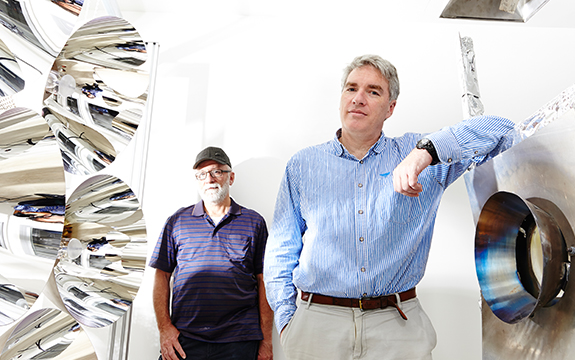Space junk is dangerous, but it’s also an opportunity

Post-doc researcher Ben Ekman (left) and Professor Geoff Brooks (right) in the research lab
In summary
- Swinburne researchers are exploring recycling on the moon
- About 200,000kg of man-made materials rest on the lunar surface
- It would save billions of dollars and rid space of hundreds, maybe even thousands, of tons of space junk if we could recycle space debris on the moon or in orbit
Space experts estimate there are over 100 million pieces or around 8,000 tons of space debris orbiting around us, mostly consisting of satellite and rocket scraps. And not all space debris is flying around in orbit.
It is estimated that about 200,000kg of space junk rests on the lunar surface and this amount will increase with the future missions.

Swinburne researchers are investigating the technology best suited to recycling on the moon’s surface. Image credit: NASA
According to the German Start-up, Orbit Recycling, more than 150 tons of aluminium alone can be regained and recycled on the moon. This would save billions of dollars; Orbit Recycling calculated the total cost of recycled aluminium on the moon to be 150,000 euro/kg, which is a fraction of the transported material cost from the earth.
A Swinburne research group led by Professor Geoffrey Brooks, Associate Professor Boris Eisenbart and Professor Alan Duffy is focused on the recycling metals on the lunar surface, working with researchers from India, China and USA on some of the challenges of mining on the moon.
Their current work looks at the furnace technology best suited to recycling on the moon. They are looking at concentrated solar energy as a source of heat, and they have been making ceramics and metals using concentrated solar energy and regolith-like materials found on the surface of the earth to address this question.
This forms part of the Swinburne Space Technology and Industry Institute’s research interest in extraterrestrial resource processing.
Lunar recycling represents a significant challenge but is a critical issue to address. All major space organisations around the world are planning lunar missions. Now is the time to think responsibly what we leave behind in our future lunar missions, especially if we want to develop sustainable human presence on the moon.
-
Media Enquiries
Related articles
-

- Student News
- Science
- Sustainability
Introducing tomorrow’s global science communicators
Start Talking is Swinburne’s unique video-based public speaking competition, exclusively for undergraduate students
Monday 08 December 2025 -

- Astronomy
- Technology
- Health
- Science
- University
- Sustainability
- Engineering
Swinburne highly cited researchers reach the top in 12 fields
Ten Swinburne academics have been named on the Highly Cited Researchers 2025 list, released by Clarivate
Tuesday 02 December 2025 -

- Science
- Engineering
Swinburne secures grant to advance next-generation metamaterials research
Swinburne physicist Dr Weibai Li has received a Discovery Early Career Researcher Award from the Australian Research Council
Tuesday 02 December 2025 -

- Technology
- Health
- Science
- University
$1.2m ARC funding to boost national X-ray spectroscopy capability through Swinburne and QUT partnership
Swinburne has secured $1.2 million in the latest Australian Research Council Linkage Infrastructure, Equipment and Facilities scheme round
Tuesday 02 December 2025 -

- Astronomy
- Technology
- Science
- Engineering
Meet Swinburne’s Roo-ver Mission team
Roo-ver will be Australia's first lunar rover, and it’s being designed, built and tested in Australia. Swinburne is playing a key role in the design and construction of Roo-ver, through its involvement in the ELO2 Consortium.
Wednesday 26 November 2025

